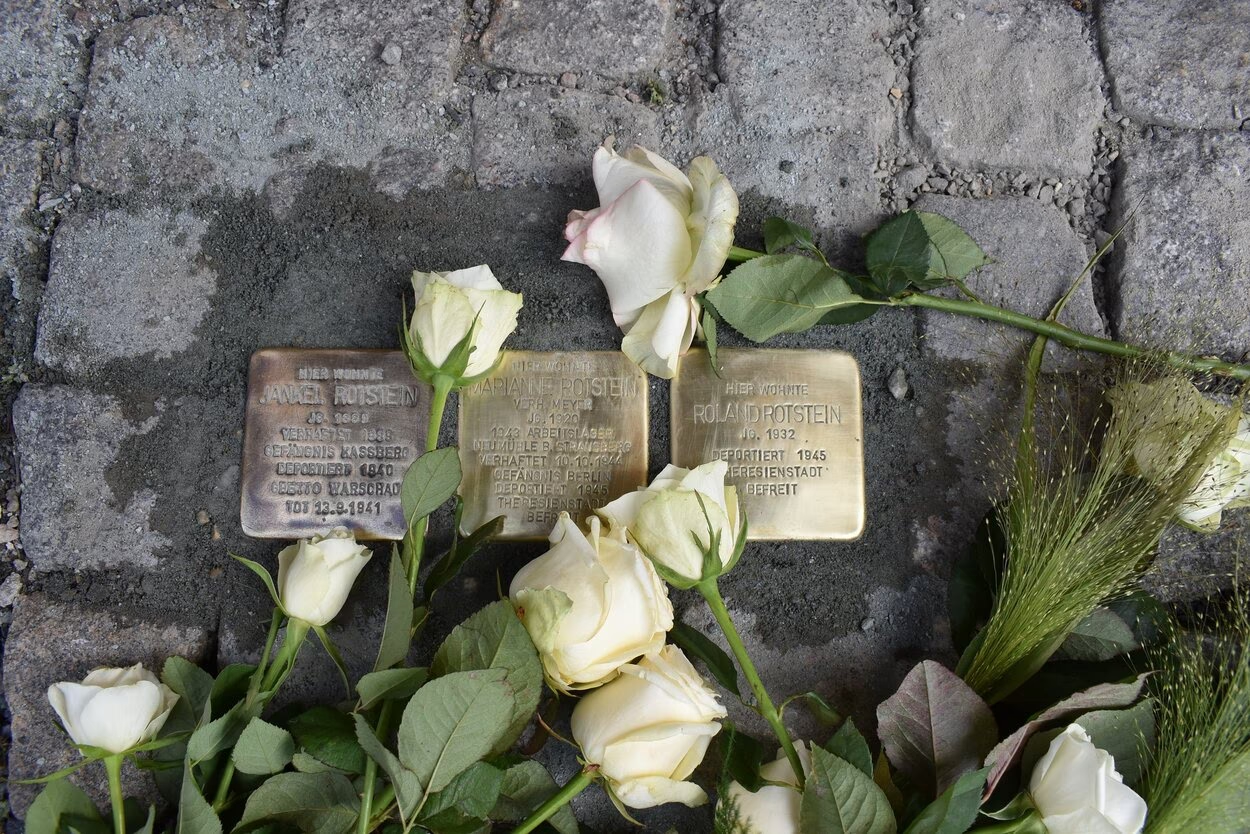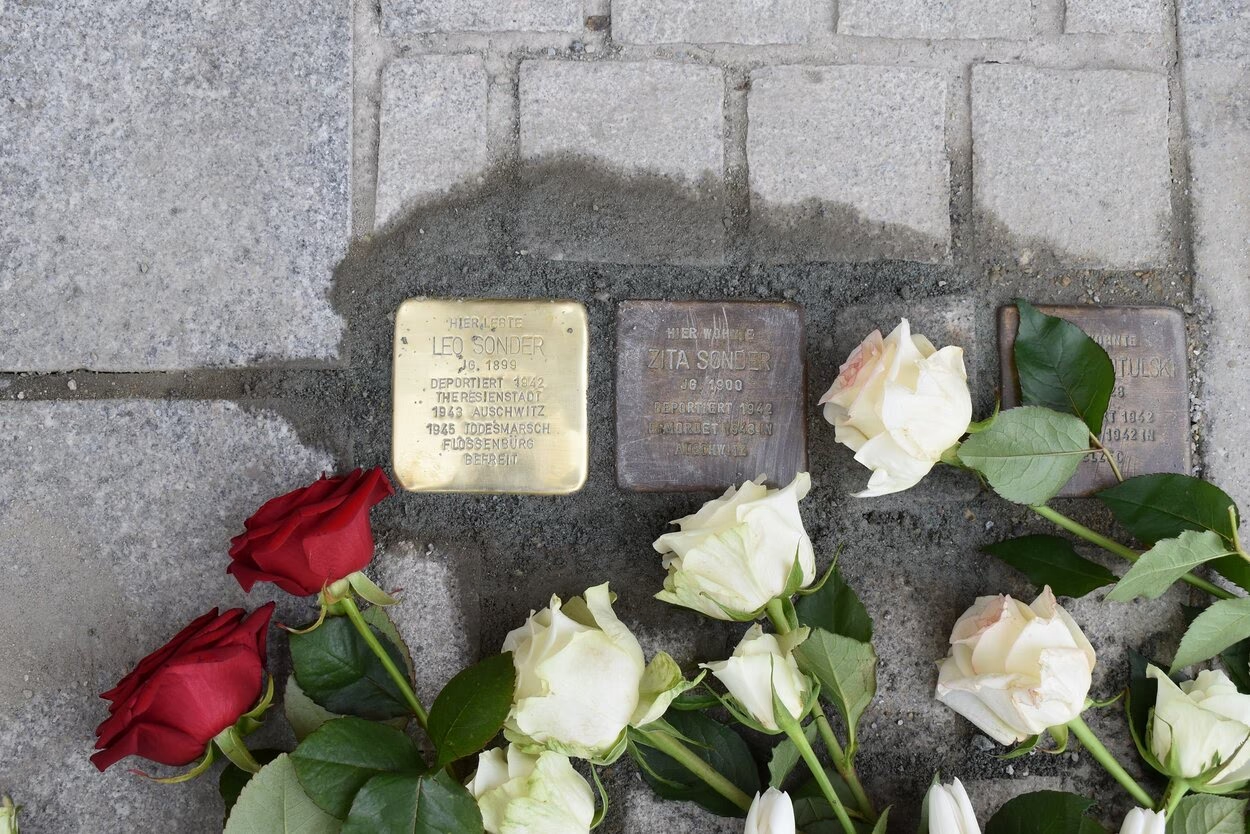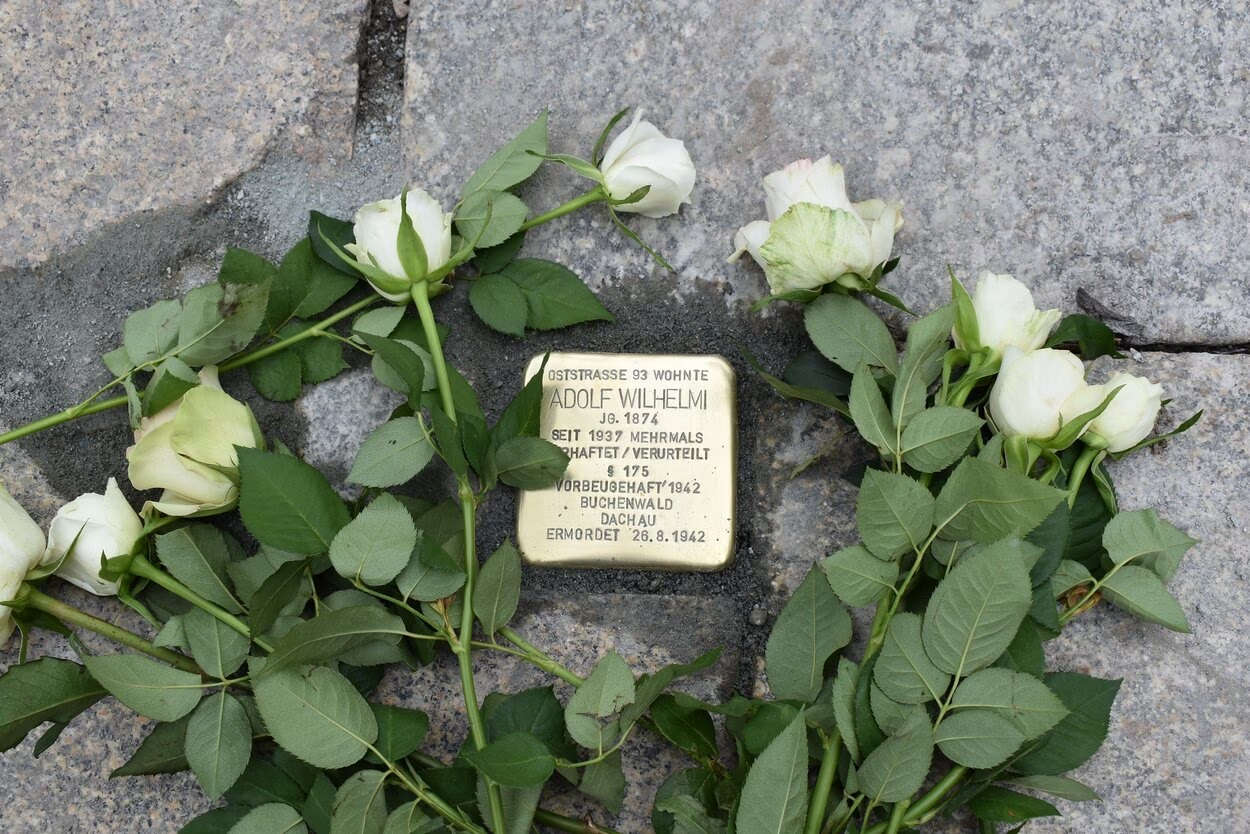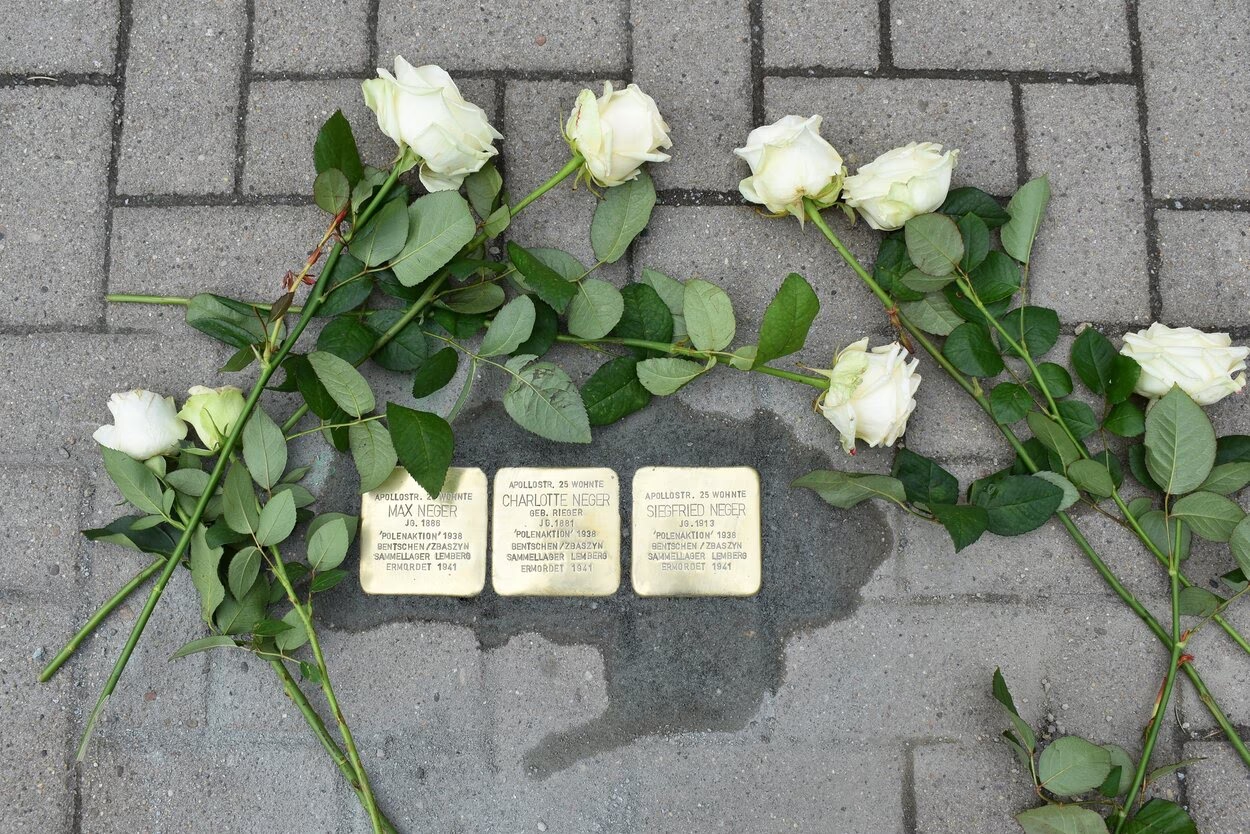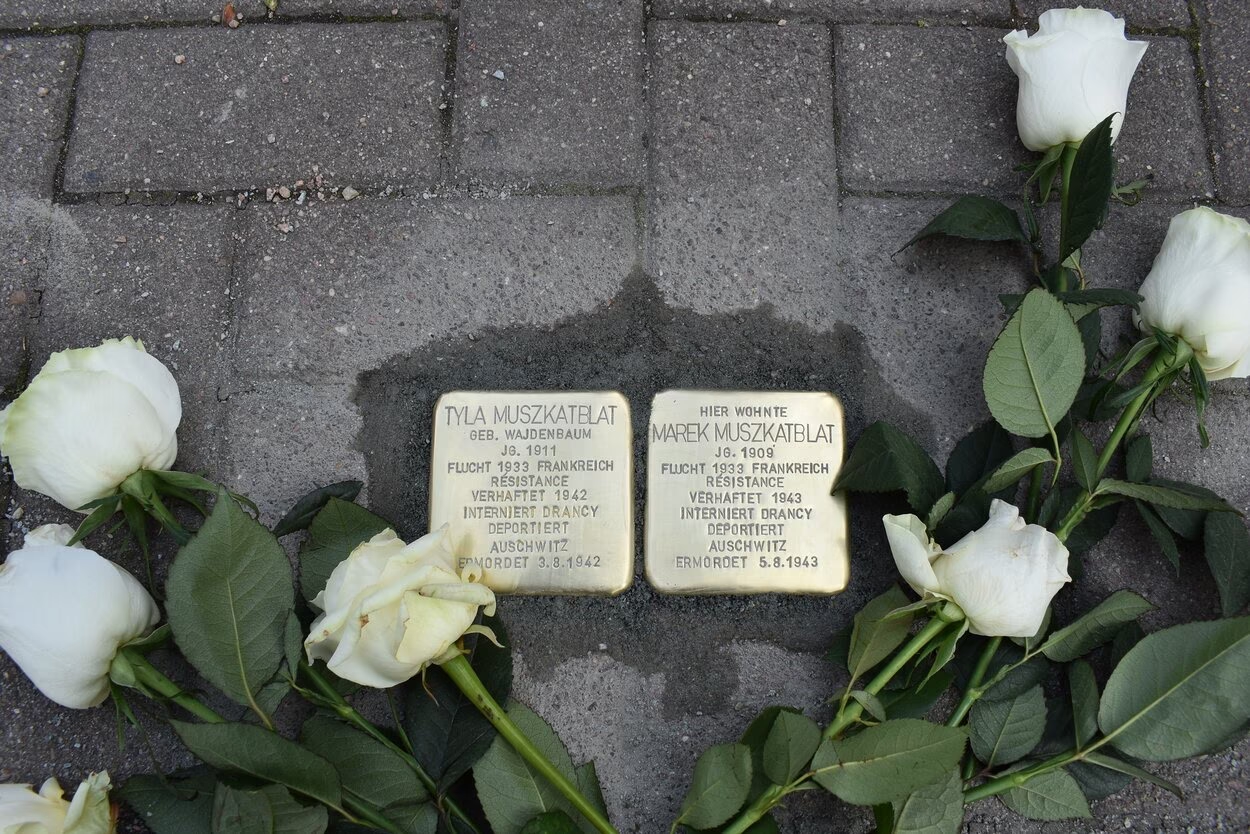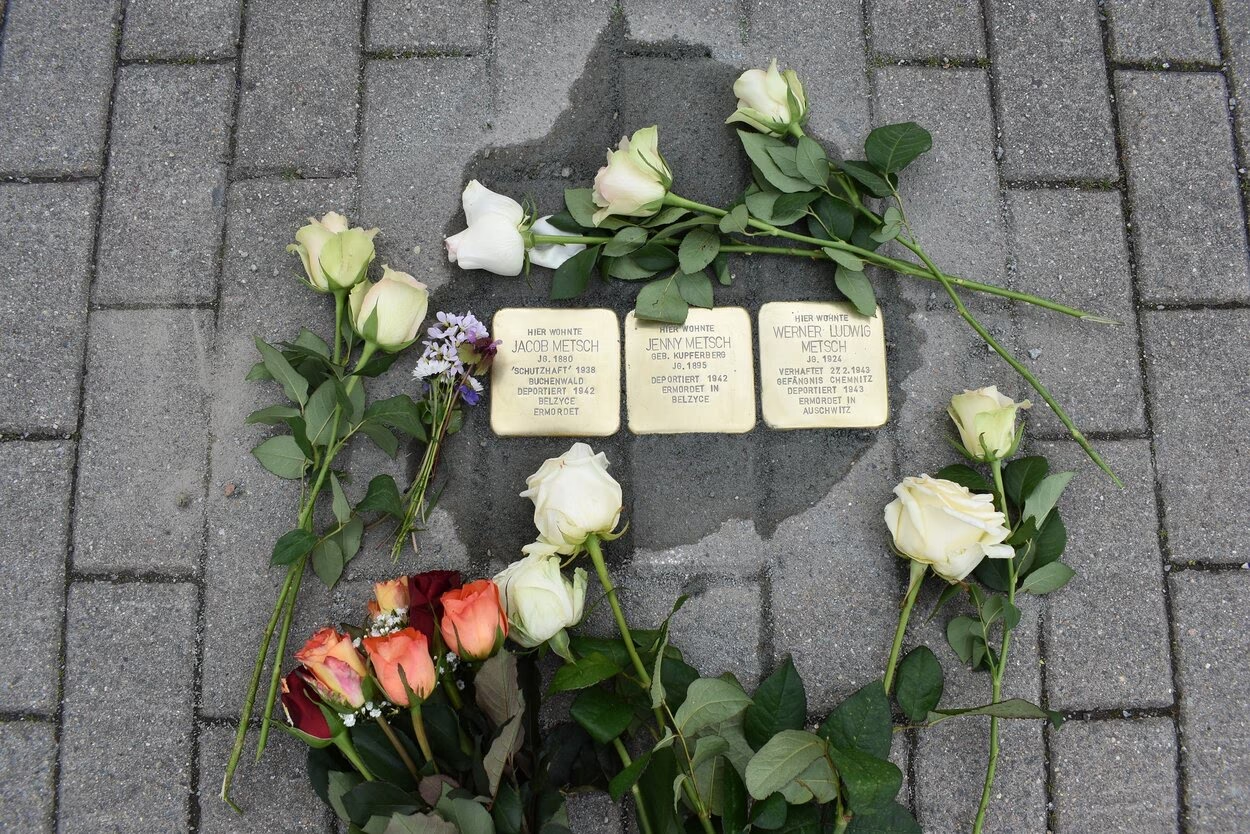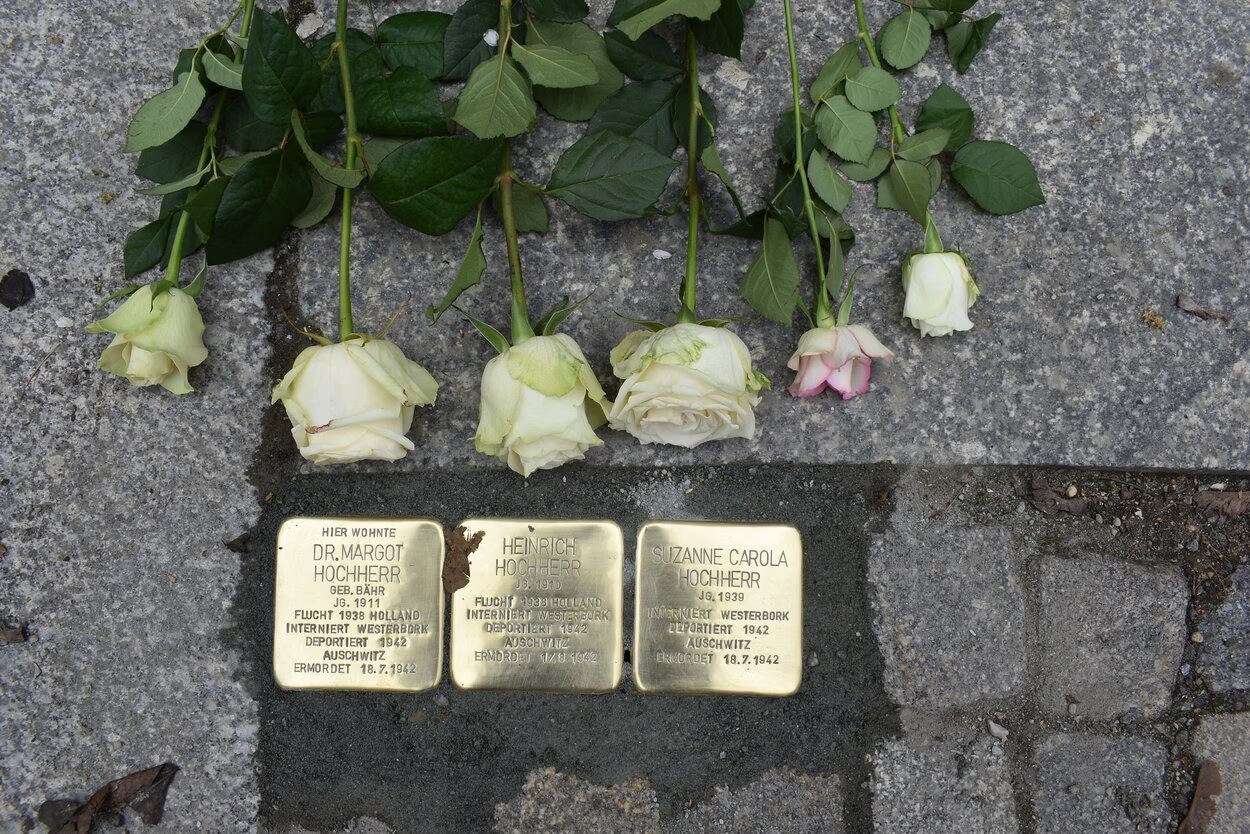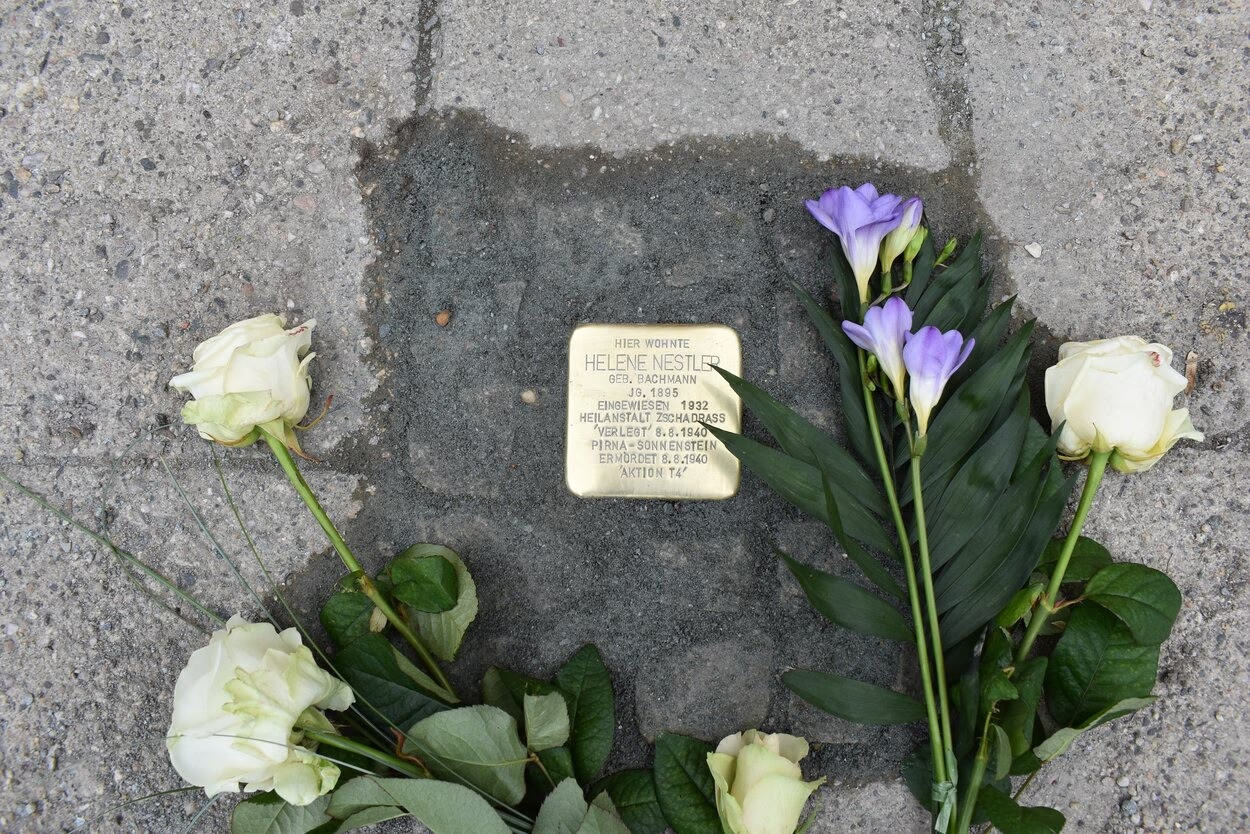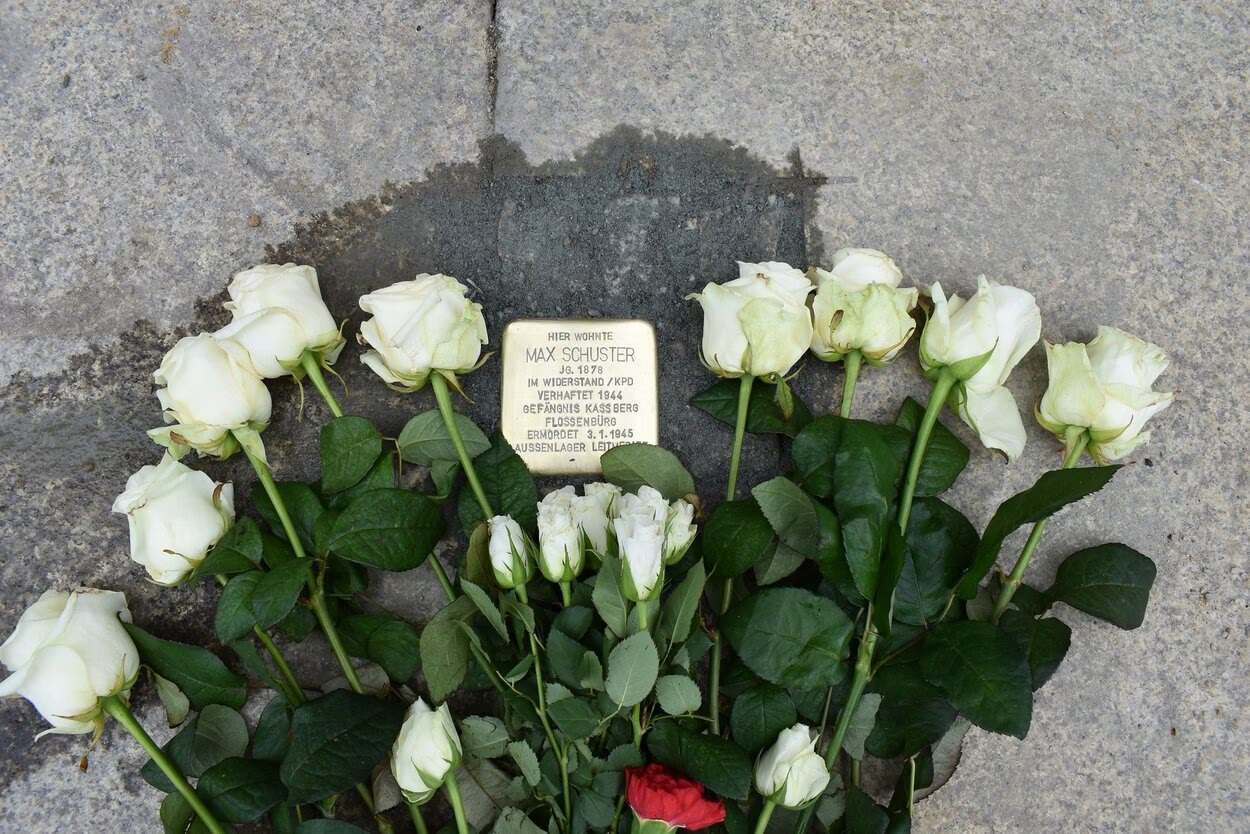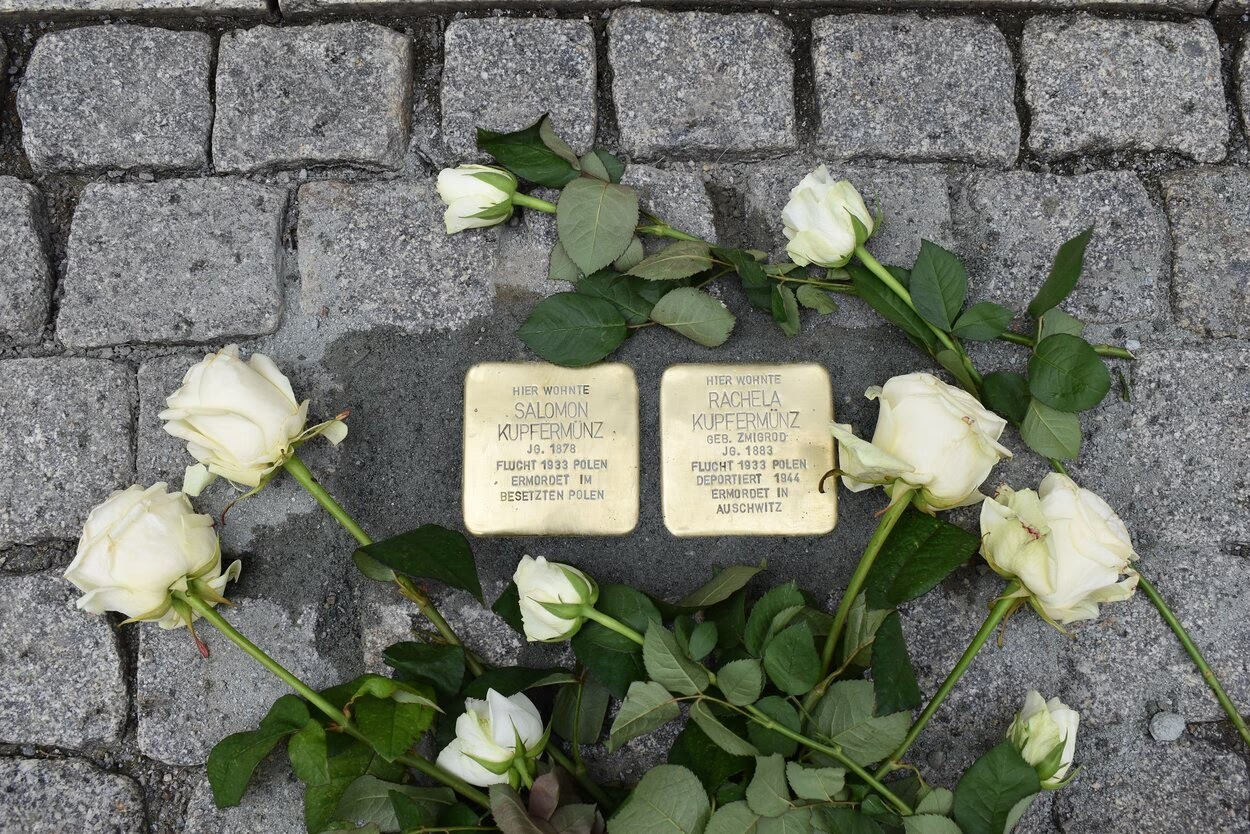Stumbling stone laying on 6 May 2021
On 6 May, 27 new Stolpersteine were laid at 13 locations in the city. For many years, the city of Chemnitz has used this project to commemorate the people who were persecuted, expelled and killed by the National Socialists in our city.
Alexanderstraße 1, today Ludwig-Kirsch-Straße 1
Stumbling stones for Marianne and Roland Rotstein
The Rotstein family lived with five children in a small flat on Sonnenberg. There is already a Stumbling Stone at this address for father Jankel Rotstein, who died of starvation in the Warsaw ghetto in September 1942. The eldest daughter Marianne Rotstein had to work in various Jewish labour camps and was deported to Theresienstadt in 1944. Her brother Roland Rotstein was also deported to Theresienstadt together with his brother Siegmund Rotstein on 13 February 1945. The siblings survived the ghetto and the typhus epidemic that broke out there. They returned to Chemnitz on 9 June 1945. Marianne Rotstein then emigrated to the USA. Roland Rotstein later lived in Lower Saxony and Berlin.
Godmother: Marion Rotstein
Zschopauer Street 74
Stumbling stone for Leo Sonder
Zita and Leo Sonder were deported to the Theresienstadt ghetto on 8 September 1942 and transferred to Auschwitz on 29 January 1943. There is already a Stumbling Stone for Zita Sonder, who died shortly after her arrival, at Zschopauer Straße 74. Leo Sonder survived Auschwitz and returned to Chemnitz together with his son Justin in June 1945.
Sponsor: Kerstin Claus
Oststraße 93, today Augustusburger Straße 121
Stumbling stone for Adolf Wilhelmi
Adolf Wilhelmi's persecution began long before the National Socialists seized power in 1933. He was first sentenced to a fine of 50 Reichsmarks by the Chemnitz district court in December 1932 for homosexual contact. This was followed by further convictions and imprisonment, including in Bautzen, Plauen, Zwickau and Siegburg. After Adolf Wilhelmi had served his full sentence, he was not released but deported to Buchenwald concentration camp near Weimar in May 1942. In July of the same year, he was deported to Dachau concentration camp near Munich, where he was murdered on 26 August 1942.
Sponsors: Alliance 90 / The Greens Chemnitz District Association
Apollostraße 25, today behind the house at Gustav-Freytag-Straße 26
Stumbling stones for Max Meschulim Neger, Charlotte Neger and Siegfried Neger
The merchant Max Meschulim Neger, who originally came from Ukraine, founded a small hosiery factory in the 1920s. As a Polish citizen, he, his wife Charlotte Neger and their son Siegfried Neger were deported to Poland on 28 October 1938. They settled in the city of Lemberg (Lwów). After Lemberg was occupied by the German Wehrmacht on 30 June 1941, the family's trail was lost. Almost all the Jews of Lviv were murdered in the following years in the Lviv collection camp set up by the Nazis - most likely including the Neger family.
Godparents: Karla Müller, Martin Niemann, pupils and teachers of the Georgius Agricola Grammar School
Gustav-Freytag-Straße 3
Stumbling stones for Marek Muszkatblat and Tyla Muszkatblatt
Marek Muszkatblat was a Jew of Russian descent and had Polish citizenship. He became politically active early on, joining the KPD in 1929. Marek Muszkatblat was exmatriculated by the Leipzig university authorities on 20 April 1932 because of his communist activities. Marek Muszkatblat emigrated to France in March 1933 and met his future wife Tyla Wajdenbaum, married name Muszkatblatt. After the armistice of Compiègne on 22 June 1940, the couple joined the French resistance, the Resistance. Both were arrested and taken to the Drancy collection camp independently of each other and deported from there to the Auschwitz extermination camp.
Sponsors: Grannies against the Right, Steffen Vogel and Beate Ressel
Stollberger Straße 39, today Stollberger Straße 25
Stumbling stones for Jacob Metsch, Jenny Metsch and Werner Ludwig Metsch
Jacob Metsch was a department manager at the department stores' H. & C. Tietz department store, where he was responsible for leather, writing and gallantry goods. He married Jenny Kupferberg on 28 July 1919. Mr and Mrs Metsch had two sons: Heinz Bernhard and Werner Ludwig. The family lived at Pornitzstraße 1 until 1936, when they found a new home on Kapellenberg at Stollberger Straße 39. On 15 April 1942, the couple were forced to move to the "Jews' house" at Apollostrasse 18. On 10 May 1942, Jenny and Jacob Metsch were deported to the Belzyce ghetto near Lublin and murdered. On 27 February 1943, Werner Ludwig Metsch - together with Justin Sonder - was deported to Auschwitz via the Hellerberg camp near Dresden and murdered there. Bernhard was able to emigrate to England in April 1939.
Godparents: Susen Döbelt, Astrid Günther and Stephan Nobis, Peer Fiedler
Platanenstraße 8, today Marianne-Brand-Straße 8
Stumbling stones for Franz Philipp Schreiber, Charlotte Schreiber and Vera Schreiber
Franz Philipp Schreiber belonged to a long-established Jewish family of factory owners in Chemnitz. The National Socialists' "boycott of Jews" hit the Seidler & Schreiber company with full force. The weaving mill was shut down in March 1939. Franz Philipp Schreiber recognised the danger his family was in from the Nazi state. His sons Konrad and Klaus were taken to England. On 20 July 1939, Franz and Charlotte Schreiber emigrated to France with their daughter Vera Schreiber. A few weeks after their arrival in Paris, they were arrested. On 19 May 1940, they were able to flee to Nice. They took their ten-year-old daughter Vera to a nearby convent for safety. In 1944, Franz and Charlotte Schreiber were discovered underground and sent to the Drancy collection camp together with their daughter Vera. From there, they were deported to Auschwitz on 27 March 1944 and murdered.
Sponsors: Friends of the Industrial Museum, Tina and Martin Böhringer, Andreas Nitschke
Heinrich-Beck-Straße 7
Stumbling stones for Elsa Hauptmann, Marianne Hauptmann and Helga Hauptmann
On 10 May 1942, Elsa Hauptmann was deported along with over a thousand Jews from central Germany to the Belzyce ghetto near Lublin, where she was murdered in the weeks that followed. Her two daughters Marianne Hauptmann and Helga Hauptmann were able to flee from the Nazis. Marianne Hauptmann emigrated to England in 1939, Helga Hauptmann to Shanghai. Both daughters moved to the USA at the end of the 1940s.
Godfather: Dr Hans-Joachim Kandler
Gerhart-Hauptmann-Platz 2
Stumbling stones for Arthur Sigler and Hedwig Sigler
Arthur Sigler was arrested during the November pogroms of 1938 and deported to Buchenwald. Immediately after his return, the entrepreneur agreed to the "sale" of his stocking factory. A few months later, he was arrested again and held in prison on Kaßberg for a long time. In the meantime, Arthur and Hedwig Sigler had managed to get their two children to safety in time on a Kindertransport to London. They themselves were deported "to the East", as the Gestapo deportation list put it, on 13 July 1942 and murdered.
Godparents: Eva Maria Josiger, Franziska Schubert and Robert Meier
Barbarossastrasse 39
Stumbling stones for Heinrich Hochherr, Dr Margot Hochherr and Suzanna Carola Hochherr
At the beginning of 1936, the dentist Dr Margot Bähr moved to Chemnitz. She began working as a dental technician for the Jewish dentist Hans Stein. Dr Margot Bähr initially lived as a subtenant at Friedrichstraße 17 before finding a room at Barbarossastraße 39. In October 1938, she married Heinrich Hochherr, the son of a tobacco manufacturer from Heidelberg. Their daughter Suzanna Carola was born the following year. In order to continue practising her profession, Dr Margot Hochherr and her family fled to Holland. When the Wehrmacht occupied Holland in May 1940, they were arrested shortly afterwards and deported to the Westerbork transit camp. From there, the family was deported to the Auschwitz extermination camp on 15 July 1942 under the command of the "East Prussian Labour Service" and later murdered.
Sponsor: Dr Christian Flade
Leonhardtstraße 23
Stumbling stone for Martha Helene Nestler
Martha Helene Nestler, née Bachmann, was one of the many people who were discriminated against by the Nazi state due to mental illness or disability and murdered in one of the "euthanasia" centres. In 1931, she was a patient at the Chemnitz mental hospital. On 3 May 1932, Helene Nestler was admitted to the Zschadraß sanatorium and nursing home at the instigation of her husband. She was one of the first patients to be transferred to the Sonnenstein killing centre for gassing in a collective transport ("Aktion T4") on 8 August 1940 and was most likely murdered on the same day.
Godmother: Renate Baldyga
Altendorfer street 7
Stumbling stone for Max Anton Schuster
The communist Max Anton Schuster belonged to a resistance group in Chemnitz. He was betrayed and arrested in autumn 1944. They were interrogated by the Gestapo and in prison on the Kaßberg. On 1 December 1944, Max Schuster and five other people (including Walter Malecki) were transferred to the Flossenbürg concentration camp on a rail transport from the Chemnitz state police station. A few days later, the prisoners were taken to Litomerice. The largest subcamp of Flossenbürg concentration camp was located there from 25 March 1944. Physically weakened prisoners were maltreated to death by the SS guards with inadequate food and hardly any medical care. This included Max Schuster, who died on 3 January 1945.
Sponsor: ver.di District Saxony West-East-South
Innere Klosterstraße 10, today Innere Klosterstraße 6
Stumbling stones for Salomon Kupfermünz and Rachela Kupfermünz
The large family of Salomon Kupfermünz and Rachela Kupfermünz, née Zmigrod, lived in an 8-room flat at Innere Klosterstraße 10. One room was used as an office for the hosiery and textile trade. However, Salomon Kupfermünz had to give up his business in the middle of the Great Depression. The couple were unable to recover from this stroke of fate. The seizure of power by the National Socialists strengthened their resolve to leave the country. It has not yet been possible to establish whether the whole family emigrated to France in August 1933. Due to a law there, according to which all foreigners without employment had to leave France again, the couple moved to Poland. From then on, they lived in Bendzin. At the beginning of the war, there were almost 25,000 Jews living in the town, who later had to "live" in a ghetto. The ghetto was cleared by the Nazi occupiers in the summer of 1943. Salomon Kupfermünz was killed during this time. Rachela Kupfermünz was deported to the Auschwitz-Birkenau extermination camp and murdered there in 1944.
Godparents: Dr Hans-Joachim Strauß, pupils and teachers of the Montessori School Chemnitz


